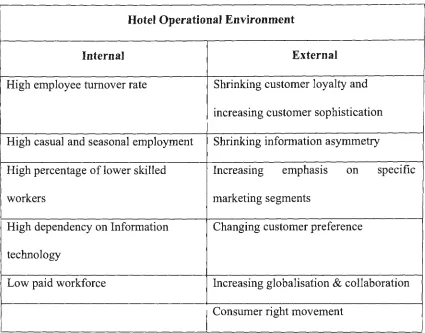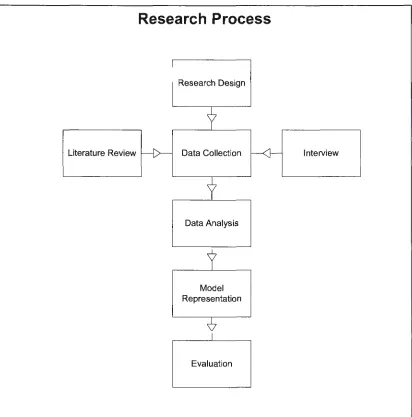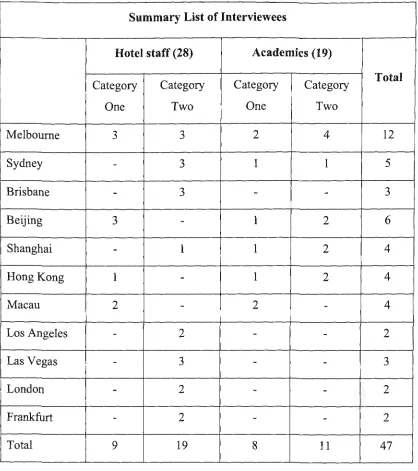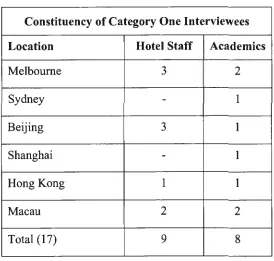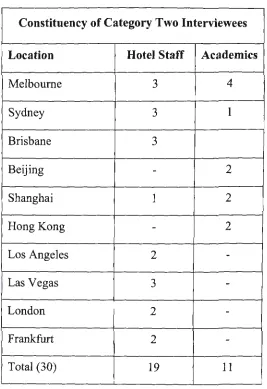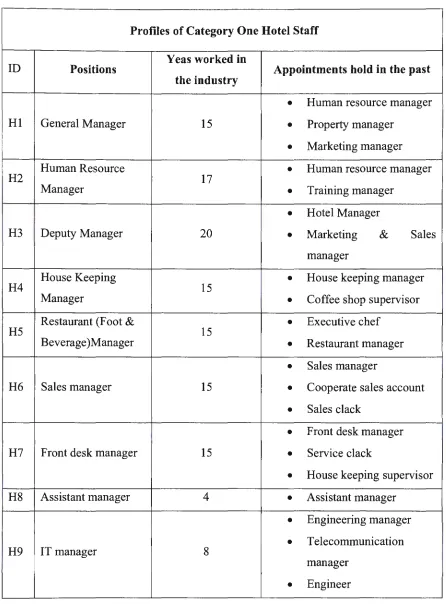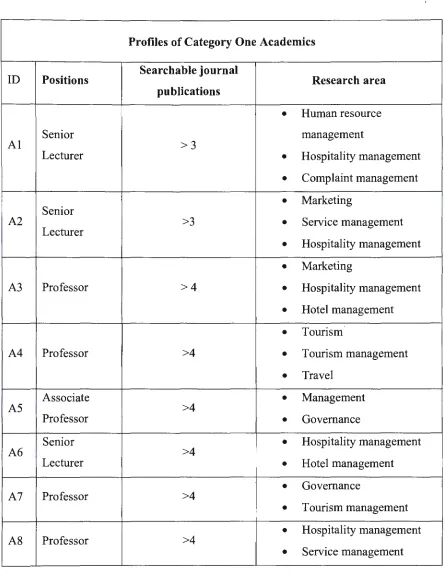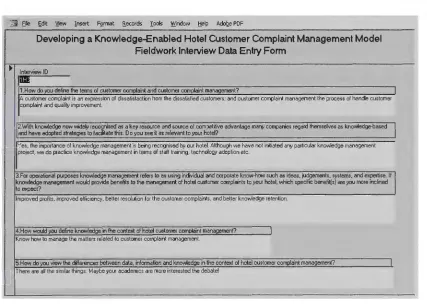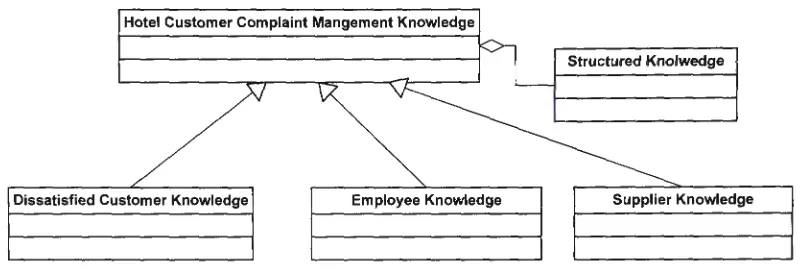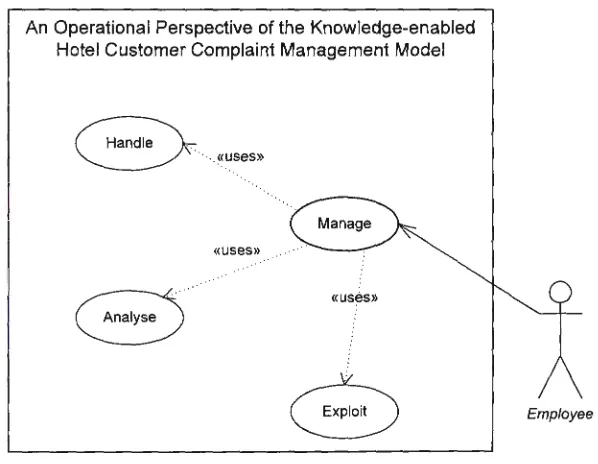Developing a Knowledge Model to Support the
Management of Hotel Customer Complaints
by
Wusheng Zhang
A thesis submitted in fulfilment of the requirement for the degree of
Doctor of Philosophy
School of Information Systems
Faculty of Business and Law
Victoria University
Australia
LIST OF PUBLICATIONS
A list of refereed publications that were authored during this research:
'Developing a Knowledge Management Strategy', International Journal of Knowledge, Culture and Change Management, vol 6, no 9, pp. 159-64, with M. Kim, 2007.
'Learning Environment Instruments', International Journal of Learning, vol 14, no 1, pp. 81-86, with M. Kim, 2007.
'Does Gender Matter in Computer Mediated Communication Based Distance Education?', International Journal of Diversity in Organisations, Communities and Nations, vol 7, no 1, pp. 49-54, with M. Kim, 2007.
'What Competitive Approach Will Be More Practical to Small and Medium Sized Tourism Enterprises?' in Proceedings of Council for Australian University Tourism and Hospitality Education (CAUTHE), Sydney, Australia CD 12 pages, with M. Kim, 2007.
'Developing a Knowledge Enabled Customer Complaint Management Model ', in Proceedings of Council for Australian University Tourism and Hospitality Education (CAUTHE), Sydney, Australia, CD 11 pages, with J. Zeleznikow and B. King, 2007.
Information Technology and Travel & Tourism, Ljubljana, Slovenia, CD pp67-79, with J. Zeleznikow and B. King, 2007.
'Different Paradigms to Enterprise Modelling Process', WSEAS Transactions on Business and Economics, vol. 3, no. 4, pp. 232-8, with M. Kim, 2006.
'How Can Knowledge Organizations Be Understood and Applied?' Review of Business Research, vol. VI, no. 4, pp. 94-98, with M. Kim, 2006.
'Data Modelling Approaches to Knowledge Representation', International Journal of Technology Knowledge & Society, vol. 2, no.3, pp. 25-32, with M. Kim ,2006.
'What Works and What Does Not: An Analysis of Application Framework Technology', Journal of Business Systems, Governance and Ethics, vol. l, no. 3. pp. 15-26, with M. Kim, 2006.
'Can Knowledge Be Managed with Information Technology and What Effect the Attempt Has on Society?' in Proceedings of I Ith Annual Conference of Asia Pacific Decision Sciences Institute, Hong Kong, pp. 271-4, with M. Kim ,2006.
'Computer Mediated Communication Based Distance Education: Gender Equity in Higher Education', in the Proceedings of International Conference BICABR 2006, Brno, Czech Republic, pp. 373-81, with M. Kim ,2006.
and Hospitality Education (CAUTHE) 2006, Melbourne, Australia, pp. 841-3, with M. Kim ,2006.
'Fundamental Assumptions in Conceptual Data Modelling Approaches', in Proceedings of the 10th WSEAS international Conference on Systems, Vouliagmeni, Athens, Greece, pp. 513-7, with M. Kim ,2006.
'Strategic Knowledge Management for SMTEs', in International Conference BICABR 2006, Brno, Czech Republic, pp. 364-72, with M. Kim ,2006.
'Systematic Support in Managing Organisational Knowledge', in Proceedings of 11th Annual Conference of Asia Pacific Decision Sciences Institute, Hong Kong, 267-70, with M. Kim ,2006.
'Developing a Complaint Management Model for Customer Oriented Organisations', in Proceedings of Council for Australian University Tourism and Hospitality Education (CAUTHE) 2006, Melbourne, Australia, pp. 386-9, with M. Kim ,2006.
'A Critical Analysis of the Application Frameworks Technology', in Proceedings of Business Research Conference 2005, Melbourne, Australia, pp. 71-9, with M. Kim ,2005.
'Effective Knowledge Representation through Data Modelling Approaches', in Proceedings of 5th International Conference on Electronic Business (ICEB) 2005, Hong Kong, China, pp. 582-6, with M. Kim ,2005.
'Strategic Knowledge Management through Information Technology in Small and Medium Sized Tourism Organisations', in Proceedings of Beijing International Conference Applied Business Research (BICABR) 2005, Beijing, China, with M. Kim, 2005
'Effective Knowledge Management through IT in SMTEs', in Proceedings of Tourism Enterprise Strategies: Thriving and Surviving in an Online Era, Melbourne, pp. 20-32, with M. Kim and J. Zeleznikow, 2005.
'Application Frameworks Technology in Theory and Practice', in Proceedings of the Fifth International Conference on Electronic Business, CHHK, Hong Kong, China, pp. 769-76, with M. Kim ,2005.
'Managing Customer Complaint Knowledge with a Systematic Approach', in Proceedings of Beijing International Conference Applied Business Research (BICABR), Beijing, China, with M. Kim and J. Zeleznikow, 2005.
'The Potential Application of Online Dispute Resolution in E-Government: Lessons Learned from Online Dispute Resolution in E-Commerce', in International Academy of Business and Public Administration Disciplines (IABPAD), New Orleans, USA, with J. Zeleznikow, 2005.
'An Integrative Approach for Developing Online Dispute Resolution', in Proceedings of JADIS International Conference e-Commerce, Lisbon, Portugal, pp. 106-13, with J. Zeleznikow, 2004.
DECLARATION
I, Wusheng Zhang, declare that the PhD thesis entitled Developing a Knowledge Model to Support the Management of Hotel Customer Complaints is no more than 100,000 words in length including quotes and exclusive of tables, figures, appendices, bibliography, references and footnotes. This thesis contains no material that has been submitted previously, in whole or in part, for the award of any other academic degree or diploma. Except where otherwise indicated, this thesis is my own work.
ACKNOWLEDGEMENTS
The completion of this work would not have been possible without the help and support
from others. I would like to thank my Principle Supervisor Professor John Zeleznikow in the School of Information Systems and Co-Supervisor Professor Brian King in the
School of Hospitality, Tourism and Marketing at Victoria University for their
continuous supervision, guidance and support.
Many other people also supported me in making this journey. I would like to thank
Professor Roman Tomasic, in the Faculty of Business and Law at Victoria University
for having me on his research project where I learned and practiced on how to conduct
fieldwork research; Mr Charles Bare, a former Deputy Ombudsman in Victoria, for his
insightful comments and suggestions on my earlier research proposal; Professor Anona
Armstrong, Director of Centre for International Corporate Governance Research at
Victoria University for her support to my research. Professor Margaret Deery and Paul
Whitelaw in the School of Hospitality, Tourism and Marketing at Victoria University
kindly introduced me to some of their associates for the conduct of interviews in the
hotel industry. Many hotel management practitioners and academics kindly gave me
their precious time to discuss their views on the subject area; numerous journal editors,
conference chairs, and paper reviewers gave comments and feedback on research
papers I submitted to various journals and conferences during my PhD candidature. The
critical feedback and comments have been a valuable source for the evaluation of the
I also wish to acknowledge the organisations and organisational unites that have
financially supported my PhD research including: Postgraduate Research Office, Victoria University for providing me with an Australian Postgraduate Award PhD Scholarship. I also received a Secomb PhD Student International Conference Travel
Award. The Victoria University Scholarship Foundation provided me with a Jane Shou Memorial Scholarship; whilst the School of Information Systems, Victoria University awarded me with PhD travel and conference funds. The Australian Sustainable Tourism Corporative Research Centre (STCRC) awarded me a PhD Supplementary Scholarship, a PhD Student International Conference Travel Award; and financial
support for attending various STCRC organised or affiliated conferences and workshops.
TABLE OF CONTENTS
LIST OF PUBLICATIONS ... I
DECLARATION ... VI
ACKNOWLEDGEMENTS ... VII
TABLE OF CONTENTS ... IX
LIST OF FIGURES ... XIII LIST OF TABLES ... XIII
ABSTRACT ... XIV
CHAPTER 1: INTRODUCTION ... 1
1.1. INTRODUCTION ... 1
1.2. BACKGROUND TO THE RESEARCH ... 2
1.3. THE PURPOSE AND OBJECTIVES OF THE RESEARCH ... 6
1.4. CONTRIBUTIONS OF THE RESEARCH ... 6
1.5. OVERVIEW OF RESEARCH DESIGN AND METHODS ... 8
1.6. THESIS STRUCTURE··· 10
1.7. CHAPTER SUMMARY AND CONCLUSIONS ... 12
CHAPTER 2: THEORETICAL FOUNDATIONS OF KNOWLEDGE MANAGEMENT AND OBJECT-ORIENTATION ... 13
2.1. INTRODUCTION ... 13
2.2. THE RESOURCE-BASED VIEW AND THE KNOWLEDGE-BASED VIEW OF THE FIRM ... 15
2.3. KNOWLEDGE MANAGEMENT APPROACHES ... 17
2.3.1. What Is Knowledge .... 17 2.3.2. Hierarchies of Knowledge ................................................. 19
2.3.3. TypesofKnowledge ...................................................... 21
2.3.4. Different Perspectives of Knowledge Management ....................................... 23
2.4.1. 2.4.2. 2.5.
Object-Oriented Modelling Principles ........................... 2 7
UML Modelling Notation .......................................... 32
CHAPTER SUMMARY AND CONCLUSIONS ... 32
CHAPTER 3: COMPLAINT MANAGEMENT IN HOTELS ... 35
3.1. INTRODUCTION ... 35
3.2. ORGANISATIONAL STRUCTURE OF HOTELS ... 36
3.3. HOTEL OPERATIONAL ENVIRONMENT ... 38
3.3.1. Internal Environment .............................................. 38
3.3.2. External Environment ......................................... 41
3.4. CUSTOMER COMPLAINTS AND MANAGEMENT.. ... 47
3.4.1. Service Failure and Customer Complaints ................................. 47
3.4.2. Relationship Focused Management ............................... 51
3.5. SERVICE MANAGEMENT APPROACHES ... 55
3.5.1. Production-Line Approach. ........................................ 56
3.5.2. Employee Empowerment Approach ............................. 57
3.6. CHAPTER SUMMARY AND CONCLUSIONS ... 58
CHAPTER 4: RESEARCH METHODOLOGY ... 61
4.1. INTRODUCTION ... 61
4.2. PHILOSOPHICAL ASSUMPTIONS ... 61
4.2.1. The Epistemological Perspective .............................................. 62
4.2.2. The Ontological Perspective ............................ 63
4.3. RESEARCH APPROACHES ... 66
4.3.1. Deduction vs Induction ............................................. 67
4.3.2. The Practical Approach of the Research ...................... 69
4.4. RESEARCH DESIGN ... 71
4.4.4.
4.5.
4.5.1.
4.5.2.
4.5.3.
4.6.
4.7.
4.8.
4.9.
4.10.
Secondary Data Collection Method ............................. 76
EMPIRICAL DATA COLLECTION ... 77
The Selection of Interviewees ...................... 77
The Questions asked at the Interviews ... 77
The Conduct of the Interviews ................ 80
DATA ANAL YSJS ... 82
MODELLING ... 84
EVALUATION ... 85
ETHICAL CONSIDERATIONS ... .' ... 87
CHAPTER SUMMARY AND CONCLUSIONS ... 88
CHAPTER 5: DATA ANALYSIS ... 91
5 .1. INTRODUCTION ... 91
5.2. DATA SOURCE.S ... 92
5.2.1. Categorisation of the Interviews ................ 94
5.2.2. Interviewee Profiles ................................................................ 96
5 .3. ANALYSIS AND INTERPRETATION ... 101
5.3.1. Data Standardisation ..................................... 102
5.3.2. Data Comparison and Interpretation ..................... 105
5.4. AN EMERGING VIEW OF THE NEEDS OF KNOWLEDGE MANAGEMENT IN HOTEL CUSTOMER COMPLAINT MANAGEMENT ... 111
5.5. THE. HOTEL CUSTOMER COMPLAINT MANAGE.ME.NT KNOWLEDGE CONCEPT ... 117
5.5.1. The Dissatisfied Customer Knowledge ........... 120
5.5.2. The Employee Knowledge ........................ 123
5.5.3. The Supplier Knowledge ......................................... 126
5.5.4. The Structured Hotel Customer Complaint Management Knowledge ... 128
5.6. CHAPTER SUMMARY AND CONCLUSIONS ... 130
CHAPTER 6: MODEL REPRESENTATION ... 133
6.2. OPERATIONAL PERSPECTIVE ... 133
6.2.1. Handling Customer Complaints ................................................. 138 6.2.2. Analysing Customer Complaints ................................................. 140
6.2.3. Exploiting Customer Complaints ............................... 143
6.3. CONCEPTUAL PERSPECTIVE ... 146
6.4. CHAPTER SUMMARY AND CONCLUSIONS ... I 55 CHAPTER 7: EVALUATING THE RESEARCH PROCESS AND OUTCOMES ... 157
7. I. INTRODUCTION ... I 57 7.2. THE RESEARCH PROCESS ... I 57 7.2.1. A Self Reflection on Interpretative Principles ........................ 157 7.2.2. Validity and Reliability of the Research .............................. 162
7.2.3. The SQL-Database Approach ... 175 7.3. THE RESEARCH OUTCOMES ... I 76 7.4. CHAPTER SUMMARY AND CONCLUSIONS ... I 80 CHAPTER 8: CONCLUSION ............... 182
8.1. INTRODUCTION ... 182
8.2. SUMMARY OF THE THESIS ... 183
8.3. IMPLICATIONS ... 192
8.3.1. Implications for Theory ............................................................ 192
8.3.2. Implications for Practice ............................................ 194
8.4. FUTURE RESEARCH ··· ... I 95 8.5. CHAPTER SUMMARY AND CONCLUSIONS ... I 96 BIBLIOGRAPHY ....... 197
APPENDIX A: INTERVIEW QUESTIONS ... 228
List of Figures
Figure 1: Research Process ... 86
Figure 2: A snapshot of the interview data input form ... 104
Figure 3: A hotel customer complaint management knowledge concept.. ... 119
Figure 4: An operational perspective of the knowledge-enabled model.. ... 135
Figure 5: Sub use case Handle ....................... 138
Figure 6: Sub use case Analyse .................................... 141
Figure 7: Sub use case Exploit .............................. 144
Figure 8: A conceptual perspective of the knowledge-enabled model.. ... 147
Figure 9: Communication channels ... 150
Figure 10: Employees ... 152
Figure 11: Dissatisfied customers ... 153
Figure 12: Types of complaint ... 154
List of Tables
Table 1: Hotel operational environment ... 47Table 2: Summary list of interviewees ... 93
Table 3: Constituency of category one interviewees ... 94
Table 4: Constituency of category two interviewees ... 95
Table 5: Profiles of category one hotel staff ... 98
Table 6: Profiles of category one academics ... 100
Table 7: Description of the base use case Manage ........................... 137
Table 8: Description of the sub use case Handle ................. 140
Table 9: Description of the sub use case Analyse ......................... 143
Table 10: Description of the sub use case Exploit ......................... 145
ABSTRACT
This study aims to develop a better understanding on how the application of knowledge management can lead to the advancement of pragmatic support in the management of hotel customer complaints. This thesis formulates a hotel customer complaint management knowledge concept and develops a knowledge-enabled hotel customer complaint management model. The formulation of the knowledge concept and the development of the knowledge-enabled model are based on an empirical investigation through interviews with domain experts. These experts include both practitioners in the hotel industry and academics in hospitality management.
The study makes contributions to the body of knowledge in both the theoretical and
practical dimensions. The thesis illustrates what is hotel customer complaint
management knowledge and how the knowledge is relevant to the management of hotel
customer complaints. The thesis demonstrates that the object-oriented modelling
approach is a useful knowledge management strategy. The thesis has also elucidated an
innovative SQL-database approach in supporting qualitative data collection, analysis,
CHAPTER 1: INTRODUCTION
1.1.Introduction
Research into the theory and practice of knowledge management in the domain of hotel
customer complaint management is an emerging field of study. The theoretical
background of the study is linked to both management and its related sub disciplines
(i.e., knowledge management, customer complaint management, problem solving, and
hospitality management), and information systems (i.e., information management,
system thinking, and modelling). Fundamentally, this research questions how to apply
the domain knowledge of hotel customer complaint management to support the
management of hotel customer complaints. The goal is to lead to the advancement of
pragmatic support.
The rationale of this study is that the application of knowledge management in this
domain might potentially provide an effective means of support to the management of
customer complaints for hotels. As such, the study has focused on investigating the
knowledge attributes, objects, and relationships in the domain. It does so in order to construct a knowledge-enabled hotel customer complaint management model that
promotes the application of hotel customer complaint management knowledge.
This chapter outlines the structure of the thesis and the nature of the problems to be
1.2.Background to the Research
Customer complaint management is relevant to all products and service providers,
since it is essential to maintaining a successful business. As Drucker (1973) has argued,
the purpose of business is to create and then retain a satisfied customer. Similarly,
Sheth and Mittal (2004) have pointed out that a business makes money only if it
satisfies its customers by catering for their needs.
Businesses dedicate considerable money and resources to research on consumer
behaviour research in an attempt to understand their target markets. Research into
customer complaint handling and management has attracted researchers from various
academic disciplines, including marketing (e.g., Fornell et al. 1984; Lovelock 1984), customer behaviour (e.g., Gilly & Gelb 1982), psychology (e.g., Brown & Leigh
1996), service management (e.g., Tax & Brown 1998), information management (e.g.,
Peacock 1995), and recently knowledge management (e.g., Bounchen 2002).
Knowledge management research reports that hotel management is slow in adopting
formal and systematic knowledge management practice and lacks the ability to plan
strategic and practical progress.
As service-oriented organisations, hotels have different characteristics from production
based industries. Lovelock (1991) has summarised six key characteristics of service
including: i) the greater involvement of customers in the production process; ii) people
as part of the product; iii) difficulties in maintaining quality standards; iv) the absence
of inventories; v) the relative importance of time factors; and vi) the nature of service
as they are produced (Lovelock 1984; Hayes & Ninemeier 2004; Reid & Bojanic 2001; Stutts & Wortman 2006). Research (e.g., Boshoff 1997; Kelley et al. 1993; Palmer et al. 2000; Seider & Berry 1998) has indicated that in practice it is not always possible to meet customer expectations, and service failures do occur. It has also been documented in the current hospitality management literature (e.g., Denham 1998; Reid & Bojanic 2006; Walker 2006) that organisations which consistently meet or exceed customer expectations in service delivery can develop good reputations and lead to good quality images, which in tum leads to customer loyalty.
The failure to provide quality services to meet customer expectations will cause bad word of mouth publicity and also the potential to lose existing customers and develop the risks associated with escalating disputes. Appropriately managed customer complaint related knowledge might lead to competitive advantages for a hotel organisation in terms of enhanced capacity and capability concerning the management of customer complaints. In the knowledge management literature (e.g., Davenport &
Klahr 1998; Davenport & Prusak 1998; Nonaka & Takeuchi 1995), it is suggested that the effective management of organisational knowledge can contribute to the attainment of sustainable competitive advantage for organisations that manage organisational knowledge systematically. With the evolution of a capital-based to a knowledge-based economy, knowledge has become a vital organisational resource and a key to business growth. A view of knowledge as a key firm resource focuses on the internal side of the firm's resources and capabilities, where differences between inter-firm performance occur through heterogonous access to valuable resources and can lead to competitive advantage (Fornell & Wemerfelt 1984; Barney 1991; Boisot 1998; Mahoney &
capabilities is potentially more sustainable than the traditional approach based solely
on product and market positioning.
Building upon the resource-based view of the firm, the knowledge-based view
contends that knowledge is the key resource and the only one capable of creating a
sustainable competitive advantage. In the knowledge-based view of the firm, internal
resources and capabilities (such as know-how, customer knowledge, efficient
processes, and expertise embedded in routines and practices that the firm transforms
into valuable products and services) are the keys to achieving sustainable competitive
advantage (Boisot 1998; Davenport & Prusak 1997; Grant 1996; Nonaka & Teece
2001; Teece 1998). Knowledge as an input to as well as an output of production is the
most important resource in the knowledge-based view. The two views are interrelated
in that knowledge has emerged as the most important organisational resource (Grant
1996; Nonaka & Takeuchi 1995; Spender 1996). Both the resource-based view and the
knowledge-based view of the firm have advanced the discussion on competitive
advantage, by acknowledging the proactive nature of business strategies.
In the hotel industry, the rapid development of information technology has promoted
greater awareness of needs about applications of knowledge management. These needs
are in terms of
a. increasing reliance on advanced technology to support business operations
(Peacock 1995;Sheldon 1997);
b. the reliance on a large number of less skilled workers (Bounchen 2002);
c. high employment turnover rates (King et al. 1998; Stauss & Seidel 2004);
d. intensifying competition (Hoffman & Chung 1999; Reid & Bojanic 2001;
Stutts & Wortman 2006).
To date, there has been little literature dedicated to knowledge management
applications in the context of hotel customer complaint management. And the uptake of
knowledge management applications in hotels appears to be slow. Additionally there is
a lack of practical guidance on how knowledge management is relevant to the
management of customer complaints in the hotel context. The present research is
anchored in the belief with that advances in knowledge management applications may
potentially provide hotels a competitive advantage.
In such circumstances, a better understanding of hotel customer complaint management
knowledge will have significance for hotels both at a strategic level and a practical level. The effective management of hotel customer complaint management knowledge
can potentially help hotels to compete in a more sustainable way, especially in the
changing economic environment where knowledge has been treated as one of the most important organisational resources.
For these reasons, it is a rationale of the study that the application of knowledge
management in the domain may potentially provide an effective means of supporting
the management of customer complaints in hotels. The study aims at extending current customer complaint management research by adopting knowledge management
applications and by modelling theories. As such, the study focuses on investigating
knowledge attributes, objects, and relationships within the domain in order to construct
1.3.The Purpose and Objectives of the Research
The purpose of this study is to develop a better understanding of how the application of
knowledge management can lead to the advancement of pragmatic support in the
management of hotel customer complaints.
This study 1s a multidisciplinary research project into the investigation of the
application of the hotel customer complaint management knowledge to the
management of customer complaint in hotel settings. It answers the question of how the
hotel customer complaint management knowledge can be used to support the
management of customer complaints. In addressing the research question, the
objectives of the study are two-fold:
ii) to identify key knowledge management attributes, objects, and
relationships that are pertinent to the application of a knowledge-oriented
approach in hotel customer complaint management; and
iii) to suggest a practical knowledge-enabled model to support the
management of hotel customer complaints.
1.4.Contributions of the Research
This study contributes to the body of knowledge in three ways:
i) It first provides a conceptual understanding of hotel customer complaint
management knowledge and how the knowledge is relevant to the
and relationships identified in this study have extended the application of
knowledge management theory to the management of hotel customer
complaints. In particular, the use of use cases and class diagrams to
communicate between the researcher (the modeller), the interviewees, and the
readers has further illustrated that the object-oriented system development
theory can be applied not only to support the development of computer
software systems but can also provide a useful facility for dialogue. In relation
to the application of modelling theories to knowledge management, this study
has illustrated that the object-oriented modelling theory can be a knowledge
management strategy in terms of providing instruments for knowledge
management applications.
ii) Knowledge artefacts such as the hotel customer complaint management
knowledge concept and the knowledge-enabled hotel customer complaint
model are practical applications of knowledge management within the domain
of hotel customer complaint management. The researcher has also formulated
a set of future research questions that are a valuable contribution for an
exploratory study (refer to section 8.4 for details). The hotel customer
complaint management knowledge concept and the knowledge-enabled model
developed in this thesis are reusable artefacts that can be directly or indirectly
applied to support hotels in adopting a knowledge-oriented approach to the
management of customer complaints. This research also contributes to the
hotel industry in terms of providing a practical guide and an alternative model
iii) The design and use of a purpose-built database and the Structured Query
Language (SQL) for the support of qualitative data collection, analysis, and
management is innovative and exploratory. It shows great potential in terms of
providing an enhanced capacity for a researcher to compare and categorise
qualitative data such as interview data. This study also provides new insights
into the role and relationships of information systems with other academic
disciplines.
This research is confined to the selection of empirical data. Respondent employees
were drawn from full service chain hotels. Academics were interviewed in hospitality
management. The interviews are aimed to gain a better understanding of organisational
customer complaint management and knowledge management practices and issues in
the hotel industry. The hotel industry has been chosen as the target domain because of
the large quantity of information that is publicly available, which allowed the
researcher to carry out an in-depth empirical study on relevant companies. Practical
access to other sectors as well as costs and time associated with more extensive travel
were further research constraints.
1.5.0verview of Research Design and Methods
This study investigates the potential knowledge management applications in the
domain of hotel customer complaint management, in order to provide conceptual
guidance. This research is focused on the theory building stage rather than theory
Due to the exploratory and theory-building nature of this study, an i nterpretative-qualitative methodology has been used to achieve the aforementioned research purpose and objectives. Data collection, analysis, and interpretation are used to support the knowledge concept formation and the construction of the knowledge-enabled model.
A semi-structured interview method was chosen for data collection, since it is well suited in cases where:
a) a better understanding of contemporary phenomena requires investigations performed in a real-life context; and
b) existing theory seems inadequate (Saunders et al. 2007; Yin 2003).
The study therefore investigates real-world customer complaint management practices: including lessons leaned and best practices for supporting the development of a knowledge-enabled hotel customer complaint management model. The data analysis process employs a set of qualitative analysis methods by classifying interview texts into meaningful themes or categories. Many researchers have studied this approach (e.g., Charmaz 2006; Miles & Huberman 1993; Strauss & Corbin 1998). Also, this research has used SQL and a purpose-built database to assist in analysis of the interview data (refer to section 5.3 for details).
1.6.Thesis Structure
The thesis is organised into eight chapters.
Chapter one is an introduction to the research.
Chapter two begins with a review of the theoretical foundations of knowledge
management and its applications. The chapter lays the theoretical foundation for the
research through a review of the existing literature including the resource-based view
and knowledge-based view of the firm (refer to section 2.2 for details), knowledge and
knowledge management (refer to section 2.3 for details).
The theoretical review also covers the object-oriented theory including the Unified
Modelling Language (UML) (refer to section 2.4 for details) which have been adopted
to represent hotel customer complaint management knowledge (refer to chapter 5 for
details) and the knowledge-enabled hotel customer complaint management model (refer
to chapter 6 for details).
Chapter three reviews the theories and practices of hotel customer complaint
management in terms of organisational structure (refer to section 3.2 for details),
operating environment (refer to section 3.3 for details), and the notion of customer
complaint and management (refer to section 3.4 for details), and service management
approaches (refer to section 3.5 for details).
Chapter four outlines the interpretative and qualitative focus of the research
(refer to section 4.2 for details). It then moves to the justification of the selection of
qualitative methods (refer to section 4.3 for details). Following a discussion of the
design (refer to section 4.4 for details), data collection (refer to section 4.5 for details),
empirical data analysis (refer to section 4.6 for details), modelling (refer to section 4. 7
for details), and evaluation (refer to section 4.8 for details). The methodology chapter
also considers the relevant ethical considerations (refer to 4.9 for details) of the
research
Chapter five illustrates how the interview data was collected, analysed, and interpreted
to support the formation of the hotel customer complaint management knowledge
concept and the knowledge-enabled hotel customer complaint model. An analysis and
interpretation of the interview data was assisted by using the Structured Query
Language (SQL) and a purpose-built database. The interview data was firstly described
(refer to section 5.2 for details), and then analysed and interpreted (refer to section 5.3 for details), and finally conceptualised (refer to section 5.4) to support the formation of
the hotel customer complaint management knowledge concept and the knowledge-enabled hotel customer complaint management model.
Chapter six introduces the knowledge-enabled hotel customer complaint management model with both the operational perspective (refer to section 6.2 for details) and the
conceptual perspective (refer to section 6.3 for details). The object-oriented theory and
the UML have been adopted to represent the model. This study has extensively used
Use Case Diagrams and Class Diagrams to enhance the communication between the researcher, the domain experts, and the readers alike. The knowledge-enabled model
of knowledge identification, creation, storage, sharing, and use to support the
management of hotel customer complaints.
Chapter seven evaluates and discusses the research progress in terms of the research
methodology and the research outcome.
Chapter eight first summarises the thesis (refer to section 8.2 for details); then moves
on to discuss the implications (refer to section 8.3) of the research. The chapter will
also discuss future research relating to this research project (refer to section 8.4 for
details).
1.7.Chapter Summary and Conclusions
This chapter introduced the research background, the purposes and objectives of the
research, the contribution of the research, the limitation of scope of the research and the
research methodology employed for the research. The chapter also included a brief
description on the topics covered in each chapter.
In the next chapter, the thesis will discuss the theoretical background of the study
through a review of existing literature. It will draw multiple inferences from related
CHAPTER 2: THEORETICAL FOUNDATIONS OF
KNOWLEDGE MANAGEMENT AND
OBJECT-ORIENTATION
2.1.Introduction
This chapter reviews the theoretical foundations relating to knowledge management
and object-oriented modelling. The review of the theory of knowledge management is
developed to support and inform the formulation of the hotel customer complaint
management knowledge (refer to chapter 5) and the knowledge-enabled hotel customer
complaint management model (refer to chapter 6).
A number of researchers have proposed or identified knowledge management
structures (e.g., Earl 2001; McAdam & McCreedy 1999; Nonaka & Takeuchi 1995).
Recently, two different knowledge management approaches have evolved. According
to Mentzas et al. (2003), the first approach is product centred and results from the
pragmatic gathering of knowledge and its representatives. It is basically concerned
with the creation and use of knowledge artefacts within a company. The second, more
process centred approach regards knowledge management as related to stepwise
fulfilment of tasks by different collaborating knowledge workers.
Research (e.g., Fahey & Prusak 1998; Krogh 1998; Sarvary 1999) has shown that
knowledge management is a process through which organisations generate and use
Despite the popularity of knowledge management in other industries, the application of
knowledge management in hotels has appeared to be rudimentary and neglected in the
literature (Bounchen 2002). Research (see Clark & Scott 2006; Cooper 2005) has
claimed that there is a greater need for tourism and hospitality organisations to use the
notion of knowledge and manage organisational knowledge. The present research
advances our understanding of the relevance of knowledge management process to the
management of hotel customer complaints. The object-oriented theory and the unified
modelling language (UML) have been adopted to represent and communicate the hotel
customer complaint management knowledge and the knowledge-enabled model.
The proponents of the object-oriented theory view the world as related through
interacted objects (Coad & Yourdon 1990). The process of interaction and message
passing between different objects can change the status of the objects. The notion of
message passing allows for a dissatisfied customer to become satisfied through an
interaction (e.g., compensation, or explanation, or apology, or a combination of such)
between the dissatisfied customer and a hotel. Although the object-oriented theory is
derived from object-oriented programming and software system design, it has recently
been used widely in business analyses.
Originally the notion of object-orientation related to the way software code was
constructed, in contrast to the then popular structured programmmg techniques.
Recently, object-oriented theory has become the mainstream approach for supporting
software system design and coding. Today, major software platforms used in industry,
such as Enterprise Java, IBM-Rational, and Microsoft.Net framework, are all
This research uses object-oriented principles to represent and communicate the
knowledge concept and the knowledge-enabled model. The Unified Modelling
Language (UML) has been adapted as the modelling notation language to depict the
concept and the model (refer to section 2.4 for details).
2.2. The resource-Based View and the Knowledge-Based View of the
Firm
Knowledge has become a vital organisational resource. It is the key to business progress and economic growth (Drucker 1994). The view of knowledge as a key firm
resource focuses on the internal side of the firm's resources and capabilities. One of the
basic propositions of the resource-based view of the firm is that firms differ in the
extent of their resource endowments (see Barney 1991; Wernerfelt 1984). The
resource-based view argues that inter-firm performance differences occur through
heterogonous access to valuable resources. This creates isolating mechanisms
representing entry barriers at the industry level and mobility barriers at the industry
group level that sustain the firm's competitive advantage (Mahoney & Pandian 1992;
Rumelt 1984).
In the resource-based view, knowledge resources are highly valuable, unique to the
organisation, difficult to copy and substitute and can lead to competitive advantage
(Barney 1991; Boisot 1998). According to Porter ( 1985), a competitive advantage
based on resources and capabilities is potentially more sustainable than the traditional
organisation attractively within this industry through one of the two generic strategies:
cost-leadership or differentiation. The market-based approach has been criticised in its
extreme form, because it is based solely on market positioning. The consideration of
organisational resources occurs primarily in the implementation phase.
Building on the resource-based view of the firm (Barney 1991; Grant 1991; Wernerfelt
1984), the knowledge-based view of the firm contends that knowledge is the key
resource and the only resource capable of creating a sustainable competitive advantage.
In the knowledge-based view of the firm, internal resources and capabilities such as
know-how, customer knowledge, efficient processes, and expertise embedded in
routines and practices that the firm transforms into valuable products and services are
the keys to achieving sustainable competitive advantage (Boisot 1998; Davenport &
Prusak 1997; Grant 1996; Teece 1998). Knowledge as an input to as well as an output
of production is the most important resource in the knowledge-based view.
Both the resource-based view and the knowledge-based view of the firm have advanced
the discussion on competitive advantage by acknowledging the proactive nature of
firms' strategies. The two views are interrelated in that knowledge has emerged as the
most important organisational resource (Grant 1996; Nonaka 1994; Spender 1996).
Knowledge is the essential enduring resource for firms (Penrose 1959; Nelson &
Winter 1982; Wernerfelt 1984). This is because organisational knowledge, as suggested
by Bollinger and Smith (2001 ), is a strategic asset which is valuable, rare,
non-substitutable and inimitable by competitors. It gives a firm a sustainable competitive
advantage. Knowledge, if properly harnessed and leveraged by an organisation will
enable it to stand out in the competition and outperform its rivals, thus maintaining its
is the knowledge within a firm and how to apply such knowledge to support the
management of the firm.
2.3.Knowledge Management Approaches
2.3.1. What Is Knowledge
The many different definitions of the term knowledge lead to different perspectives on
organisational knowledge and thus to different concepts of interventions into an
organisation's way of handling knowledge. Knowledge has been categorised as
existing in a collection of forms such as: practical, intellectual, small talk, spiritual and
unwanted (Machlup 1980); symbolic, embodied, embrained and encultured (Collins
1993); core, advanced and innovative (Zack 1999a). Some classifications of knowledge
use a dichotomy to describe one type of knowledge and its opposite such as codified
versus personalised knowledge (Zack 1999b) and tacit versus explicit knowing
(Polanyi 1966). The effectiveness of knowledge management relies on the ability of an
organisation to use the right combinations of knowledge management activities.
Related concepts include intellectual capital or knowledge assets, organisational
competencies (Prahalad & Hamel 1990) and organisational capabilities (Kogut &
Zander 1992; Kogut & Zander 1995; Teece et al. 1997).
According to Leonard-Barton ( 1995), there are four core capabilities of a firm:
a) physical systems - competencies accumulated in material systems that are built
over time such as databases, machinery, and software;
c) managerial systems - organised routines directing resource accumulation and
deployment creating the channels through which knowledge is accessed and
flows such as education, reward, and incentive systems; and
d) the organisation's values and norms determining the kinds of knowledge
sought and nurtured, and the kinds of knowledge-building activities tolerated
and encouraged within an organisation.
These four organisational core capabilities represent dynamic knowledge pools and the
resources to manipulate them from the first two, and knowledge-control or channelling
mechanisms from the last two.
Organisations are also generators of dynamic capabilities that emphasise the key role of
strategic management in appropriately building, integrating and reconfiguring internal
and external organisational skills and resources to match emerging environmental
opportunities (Teece et al. 1997). Dynamic capabilities are rooted in high performance
routines operating inside the firm, embedded in processes and conditioned by
organisational history. Organisations serve both as sources of new combinations and
provide a stable hierarchy of path-dependent routines and capabilities that are
continuously replicated (Kogut & Zander 1992). Replication mechanisms bring
stability and continuity, whereas routines serve as organisational memory.
The creation of knowledge will always be conceptualised in the framework of old
established routines. These can be dynamic or static. Static routines replicate
organisational and technological capabilities and dynamic routines enable the firm to
learn by creating, transferring and integrating knowledge. The organisational routines
are activities that are required when firm specific knowledge and resources are
et al. 1997). Such capabilities are valuable, rare, and idiosyncratic. They are hard to
imitate and define the firm's fundamental business. Tacit knowledge and organisational
memory reside in an organisation's structure via the routines that the organisation
maintains (Cyert & March 1963; Nelson & Winter 1982). Such capabilities are also
potential core competencies.
Core competences or distinctive capabilities are combinations of resources and
capabilities unique to a specific organisation and generate a competitive advantage. The
competitive advantage is based on firm specific core competencies or distinctive capabilities in which knowledge acts as the foundation for competence development
and leveraging (Prahalad & Hamel 1990). Consequently, such competence building and
leveraging is essentially knowledge based. By its very nature, tacit knowledge is
complex and difficult to imitate, playing a role in building, leveraging, and conserving
core competencies.
2.3.2. Hierarchies of Knowledge
Many authors have avoided an epistemological debate on the definition of knowledge,
by comparing knowledge with information and data. Data, information, and knowledge are not interchangeable concepts. Watson (1998) has described data as a
collection of facts, measurements, and statistics. There is no inherent meaning in data.
claimed that information is organised or processed data that is timely (i.e. inferences
from the data are drawn within the time frame of applicability) and accurate (i.e. with
regard to the original data). Jonscher (2000) describes information as data interpreted
by the person who is being informed. Information, then, can be thought of as a message
that is intended to have an impact on the receiver. Knowledge resides in the user's
subjective context of action based on information (Nonaka & Takeuchi 1995). It is the
social construction element of information that has important consequences for
knowledge constructs.
Knowledge has been discussed as something that is actively constructed in a social
setting (Wenger et aL 2002). Group members produce knowledge by their interactions,
creating a group memory. Social constructivism views knowledge not as an objective
entity but as a subjective, social artefact (Berger & Luckmann 1967). Social
constructivists argue that knowledge is produced through the shared understandings
that emerge through social interactions.
As individuals and groups of people communicate, they mutually influence each
other's views and create or change shared constructions of reality. This perspective
views knowledge as context dependant and thus as something that cannot be
completely separated from the people that hold the knowledge. The context helps
distinguish between knowledge and information. The implication is that knowledge has
strong experiential and reflective elements that distinguish it from information in a
given context. Having knowledge implies that it can be exercised, for example to solve
a problem, whereas having information does not carry the same nuance. An ability to
act is an essential part of being knowledgeable. For example, two people in the same
to the same degree of achievement. Hence there is a difference in the human capability
to add value.
Knowledge is not a radically different concept from information, rather information
becomes knowledge once it is processed in the mind of an individual. In effect,
understanding what data, information, and knowledge are and how to get from one to
another, could be the quintessence of knowledge management initiatives. In contrast to
the often assumed hierarchy from data to information to knowledge, Tuomi ( 1999) has
argued an alternative inverse view, namely that knowledge must exist before
information can be formulated and data can be measured to form information. In other
words, raw data does not exist in prior thought and knowledge processes are always
employed in identifying and collecting even the most elementary data. Tuomi has also
stated that knowledge exists which, when articulated, verbalised and structured,
becomes data. The important point of this argument is backed up by the fact that
knowledge does not exist outside of the person having the knowledge and it is indelibly
shaped by one's needs as well as one's stock of knowledge. Nevertheless, the
hierarchical view of data, information and knowledge has been and will have a
continued influence on the management of knowledge.
2.3.3. Types of Knowledge
Aside from the hierarchical view of knowledge, researchers seem to agree that there are
two types of knowledge, with a strong distinction being made between explicit and tacit
organisation such as reports, articles, manuals and patents as well as software and
pictures. It can also be found in the representations that an organisation has of itself
such as organisational charts, process maps, mission statements and domains of
expertise.
As opposed to explicit knowledge, which is knowledge that is readily communicable
and easy to transfer, tacit knowledge is more difficult to express to others (Polanyi
1966). Tacit knowledge cannot be easily codified and can only be learned through
observation and practice (Grant 1996; Kogut & Zander 1992). The problem of tacit
knowledge, its acquisition and epistemic status has been the focus of considerable
philosophical investigation. Michael Polanyi in 1962 first developed the notion of tacit
knowledge based on the observation that we know more than we can say. He (1962)
argued that a large part of human knowledge is occupied by knowledge that cannot be
articulated, that is tacit knowledge. According to Polanyi (1973), tacit knowledge is
personal knowledge that is hard to formalise or articulate, embedded in individual
experience and is shared and exchanged through direct, face-to-face contact. It is a type
of knowledge that people believe that can only exist in the human mind.
Tacit knowledge has been discussed with regard to organisational routines. Nonaka
(1994) has argued that tacit knowledge is deeply rooted in action, commitment and
involvement in a specific context. Tacit knowledge resides in individuals. To be useful,
it must be integrated into the organisation's rules and routines. Tacit and explicit
knowledge can range from highly tacit to fully articulatable knowledge and should be
rooted in organisational coordination mechanisms and routines. Nonaka and Takeuchi
(1995) expound this views in their book "The Knowledge-creating Organisation",
This means that even tacit knowledge can be transformed to explicit knowledge by a
sharing of metaphors and analogies during social interaction.
2.3.4. Different Perspectives of Knowledge Management
Knowledge management is a broad and developing field of study represented in a range
of topics such as organisational science, cognitive science, linguistics and
computational linguistics, information technology, information and library science,
anthropology and sociology, and communication studies. This has resulted in an
enormous output of writing and research in a proliferation of perspectives, methods,
systems, frameworks and models all purporting to explain knowledge management or
some part of it (e.g., AP&QC 1996; Argyris & Schon 1978; Bohn 1994; Brooking
1996; Demarest 1997; Earl 2001; Eccles 1991; Edvinsson & Malone 1997; McAdam &
McCreedy 1999;Meyer & Zack 1996; Nonaka & Takeuchi 1995; Norton 1996; Roos
1998; Sveiby 1997; Wiig 1993; Zack 1999a).
Despite the vast amount of research about knowledge management conducted in the
last decade, there is little consensus regarding its definition. Some authors simply avoid
the term completely, preferring to focus on specific aspects of the topic such as
knowledge, innovation or learning (Costello 1996). The debate on the nature of
knowledge management has been generally around two-school of thoughts, those
focusing on information systems/technology and those focusing on general
management issues. There are likely four distinct perspectives:
d) strategy
on knowledge management. Each perspective leads to a different definition of
knowledge management.
One way to define knowledge management can be traced in the concepts of
organisational learning and organisation memory. When members of an organisation
collaborate and communicate ideas, teach, and learn, then knowledge is transformed
and transferred from individual to individual. The term learning organisation refers to
an organisation's capability to learn from its past experience (Dibella 1995). Before an
organisation can improve, it must first learn. If knowledge management is seen as
organisational learning as the process of internalising and converting information to
knowledge, simply delivering or pushing information to the user's desktop may not be
an effective knowledge management strategy (Manville & Foote 1996). This is due to
the scarcity of user attention required for processing this information and converting it
to knowledge. In addition to the provision of the necessary information (the raw
material for knowledge creation), individuals should be motivated to convert it into
knowledge by learning and internalising the information. Consequently, knowledge is
created and shared on the basis of pull by individuals and not a centralised
technology-enabled push of information to desktops.
A learning organisation must have an organisation memory and a means to save,
represent, and share the organisational knowledge. Thus, establishing a corporate
memory is critical for success (Brooking 1999). The learning organisation is one that
performs five main activities:
a) systematic problem solving,
c) learning from past experience,
d) learning from the best practices of others, and
e) transferring knowledge quickly and efficiently throughout the organisation
(Garvin 1993).
When faced with issues or problems to be solved, individuals ideally tap into this
memory for both explicit and tacit knowledge. Human intelligence draws from the
organisational memory and adds value by creating new knowledge. Information
technology plays a critical role in organisational learning and management must place
emphasis on this area to foster it. A knowledge management system can capture the
new knowledge and make it available in an enhanced form.
Along with the organisational learning approach to knowledge management, the
process approach has also been well accepted by researchers. The process approach
refers to a procedure through which organisations generate and use their institutional
and collective knowledge (e.g., Fahey & Prusak 1998; Krogh 1998; Sarvary 1999)
whereas Davenport and Prusak ( 1998) explain that knowledge management process is
about acquisition, creation, packaging and application or reuse of knowledge.
Similarly, Brown and Duguid (1991) have viewed knowledge management as a
systematic process of finding, selecting, organising, and presenting information in a
way that improves a user's comprehension and use of business assets.
The goal of knowledge management as a process is to improve the organisation's
ability to execute its core processes more efficiently: eliminating the need to
continuously reinvent ways to accomplish a task. Managing knowledge thus goes much
asset but also managing the processes that act upon the asset. Accordingly, detailed
knowledge of the processes enables workers to optimise procedures.
Davenport and Prusak (1998) have stated that knowledge management is a compelling
new information technology that can help organisations leverage their knowledge
capital for increased competitive advantage. It can endeavour both to capture explicit
and tacit information and knowledge that exists in the organisation, usually in the
minds of employees, in order to advance the organisation's mission. DiMattia and Oder
(1997) have suggested that knowledge management involves blending a company's
internal and external information and turning it into actionable knowledge via
technology platform. A study from AP&QC (1996) shows that organisations embarking
in knowledge management efforts generally rely, for accomplishing their goals, on the
setting up of a suitable information technology infrastructure. There is an ongoing
debate about the danger that technology driven knowledge management may end up
objectifying knowledge into static and inert information thus neglecting the overall role
of tacit knowledge.
Knowledge management can be defined in terms of the use of knowledge for
competitive advantage. In this regard, knowledge management is viewed as a strategy
for effectively managing knowledge. When used wisely, it can confer strategic or
competitive advantage on an organisation (Grant 1991). To use knowledge
management for competitive advantage requires both strategy formulation and strategy
execution. Knowledge management involves a strategic commitment to improving the
organisation's effectiveness. Stewart (1997) has argued that a goal of managing
of organisational performance will not be achieved alone, but within the prime contexts
of people, business strategy, knowledge, organisational milieu, and technology.
Combing the four perspectives from the literature, knowledge management refers to a
systematic and integrative process of co-ordinating organisation-wide activities of
acquiring, creating, disseminating, and using knowledge by individuals and groups.
Organisational knowledge activities are part of the organisation's repository and that
typically resides within the organisation through information technology where
possible to achieve organisational goals. The conduct of knowledge management in an
organisation involves manoeuvring organisational knowledge through executing
knowledge management activities that operate on the organisation's knowledge
resources. Firms must intentionally and strategically manage not only knowledge but
also its activities that manage the knowledge. Thus, it is essential to examine
knowledge management activities.
2.4.0bject-Oriented Theory
2.4.1. Object-Oriented Modelling Principles
The basic object-oriented modelling construct of an object builds on the concept of an
imaginary actor, as originally proposed by Kay ( 1984 ), where an actor is any object
that behaves in predefined ways. Actors can be used to model real objects, but they can
also be used to model imaginary objects that represent people's ideas. An actor view of
modelling is based on the idea that a description of data with its permissible operations
approaches (see Kowalski 1979) and production rules based approaches (see Buchanan
& Shortlife 1984) first developed in the 1970s.
In Minsky's (1975) seminal work "Aframeworkfor presenting knowledge'', he views a
frame as a structure for holding a collection of interrelated knowledge about a concept,
a physical object, a system state or an event. It is a very effective way to model
knowledge of a stereotyped object and to communicate the concepts and the processes
of a problem domain amongst a modeller and experts. The object-oriented approach has
become widely acceptable by both business modelling and systems development
communities since the 1990s.
An object-oriented conceptual modelling approach can model not only the taxonomy
relationship of a problem domain, but also how the value and status of an object can be
altered through message passing between objects. An object is a building block of any
models in object-oriented modelling. Coad and Yourdon (1990) have depicted that an
object is an abstraction of something in a problem domain, reflecting the capabilities of
the system to keep information about it, interact with it or both. In that sense objects are
used to model an understanding of the application domain. The object-oriented
modelling approach provides not only a categorisation for a knowledge domain, but
also processes that support the use of the knowledge through communication. In
object-oriented modelling, the communication among objects is achieved through message
passing between each object.
This research project has adopted the notion of abstraction, generalisation &
management knowledge, and the knowledge-enabled hotel customer complaint
management model.
Abstraction is one of the principal concepts of the object-oriented modelling theory. It
aims to reduce details required for models. The notion of abstraction is related to
developing a line of thought from a concrete reality to a general principle or an
intellectual idea; a concept or term that does not refer to a concrete object but that
denotes a quality, an emotion, or an idea. A closer working definition of abstraction
defined by Graham (2001, pp 17.) as "representing the essential features of something
without including background or inessential detail". The main benefit of the
application of abstraction is the expertise which can be reused. The notion of
abstraction permits a modeller to develop a description of a complex domain problem
by only retaining the features that are of direct relevant to the phenomena being
modelled. Thus, the notion of abstraction provides a useful facility for knowledge
modelling, not only at an operational perspective, but a conceptual perspective. The
operational perspective of a model is concerned with the usefulness of a model. By
contrast a conceptual perspective of a model is concerned with the understanding the abstraction of concepts in a given problem domain.
Generalisation & specialisation describe logical relationships between objects. Fowler
(1997) has stated that generalisation is a taxonomic relationship between a more
general element and a more specific element that is fully consistent with the general
element and that adds additional information. Specialisation on the other hand, is the refinement of an abstraction by adding additional features. The generalisation and
